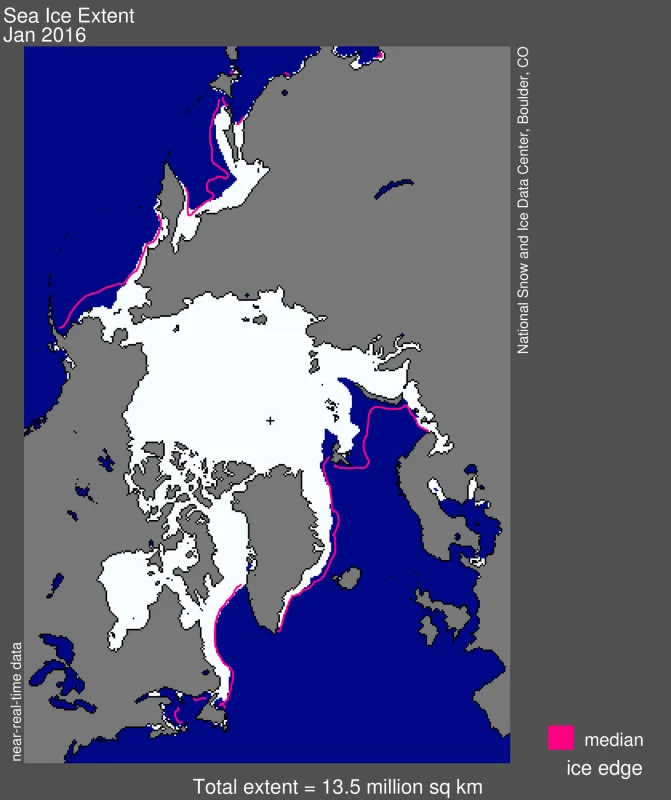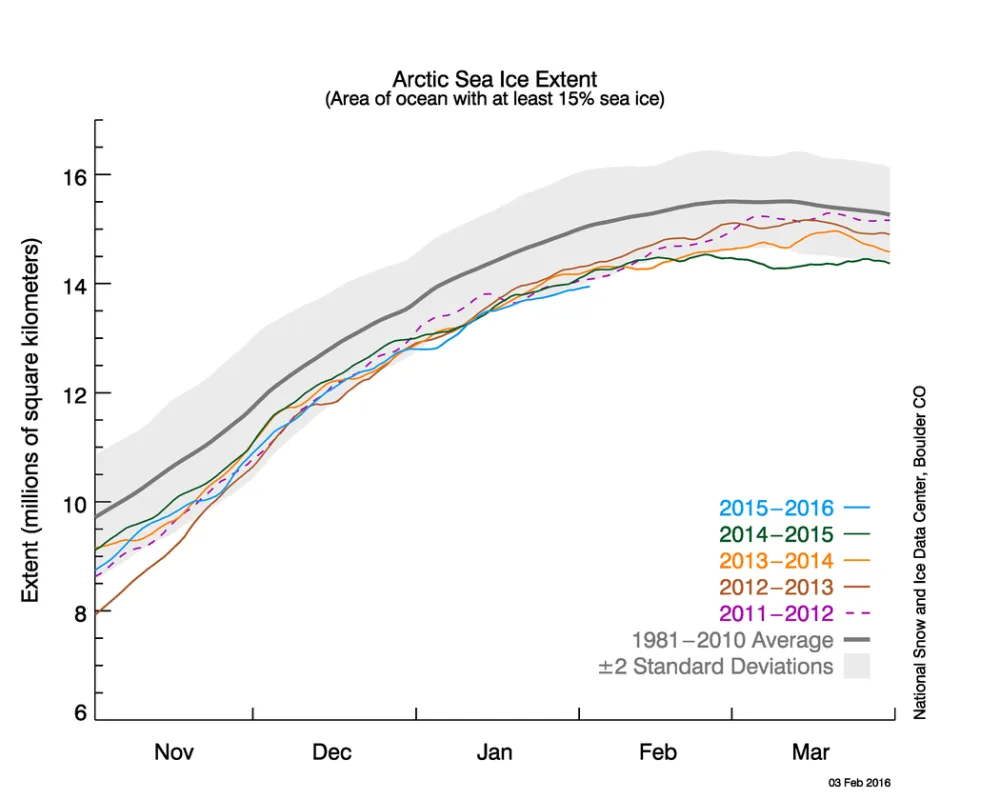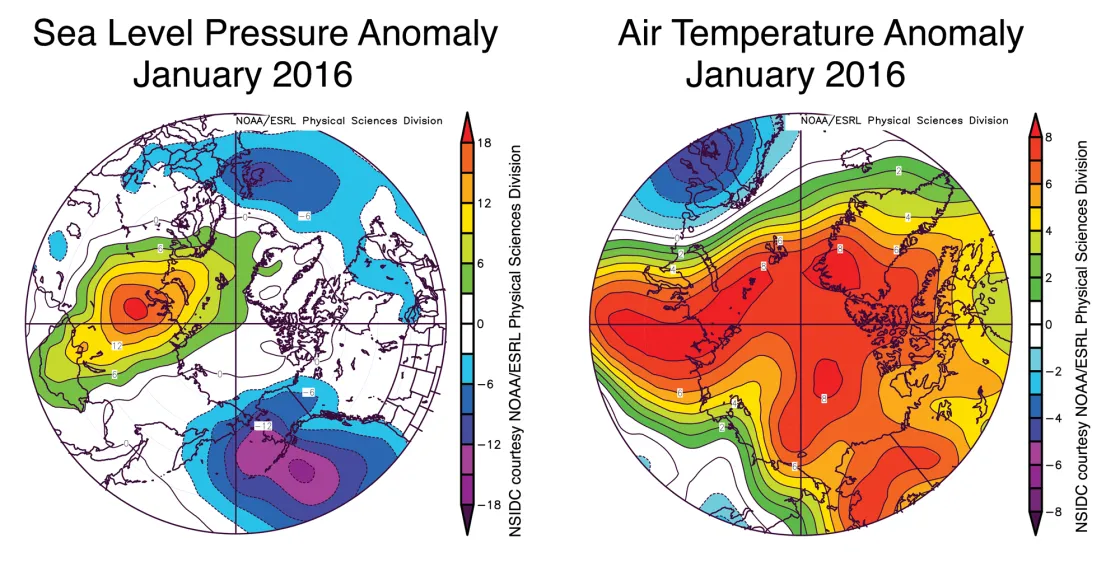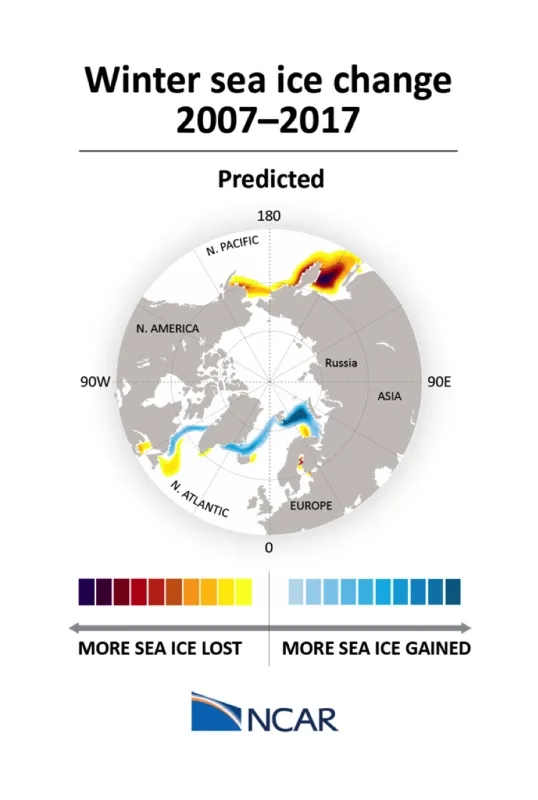January Arctic sea ice extent was the lowest in the satellite record, attended by unusually high air temperatures over the Arctic Ocean and a strong negative phase of the Arctic Oscillation (AO) for the first three weeks of the month. Meanwhile in the Antarctic, this year’s extent was lower than average for January, in contrast to the record high extents in January 2015.
Overview of conditions
Arctic sea ice extent during January averaged 13.53 million square kilometers (5.2 million square miles), which is 1.04 million square kilometers (402,000 square miles) below the 1981 to 2010 average. This was the lowest January extent in the satellite record, 90,000 square kilometers (35,000 square miles) below the previous record January low that occurred in 2011. This was largely driven by unusually low ice coverage in the Barents Sea, Kara Sea, and the East Greenland Sea on the Atlantic side, and below average conditions in the Bering Sea and Sea of Okhotsk. Ice conditions were near average in Baffin Bay, the Labrador Sea and Hudson Bay. There was also less ice than usual in the Gulf of St. Lawrence, an important habitat for harp seals.
Conditions in context
January 2016 was a remarkably warm month. Air temperatures at the 925 hPa level were more than 6 degrees Celsius (13 degrees Fahrenheit) above average across most of the Arctic Ocean. These unusually high air temperatures are likely related to the behavior of the AO. While the AO was in a positive phase for most of the autumn and early winter, it turned strongly negative beginning in January. By mid-January, the index reached nearly -5 sigma or five standard deviations below average. The AO then shifted back to positive during the last week of January. (See the graph at the NOAA Climate Prediction website.)
The sea level pressure pattern during January, which featured higher than average pressure over northern central Siberia into the Barents and Kara sea regions, and lower than average pressure in the northern North Pacific and northern North Atlantic regions, is fairly typical of the negative phase of the AO. Much of the focus by climate scientists this winter has been on the strong El Niño. However, in the Arctic, the AO is a bigger player and its influence often spills out into the mid-latitudes during winter by allowing cold air outbreaks. How the AO and El Niño may be linked remains an active area of research.
January 2016 compared to previous years
The monthly average January 2016 sea ice extent was the lowest in the satellite record, 90,000 square kilometers (35,000 square miles) below the previous record low in 2011. The next lowest extent was in 2006. Interestingly, while 2006 and 2011 did not reach record summer lows, they both preceded years that did, though this may well be simply coincidence.
The trend for January is now -3.2% per decade. January 2016 continues a streak that began in 2005 where every January monthly extent has been less than 14.25 million square kilometers (5.50 million square miles). In contrast, before 2005 (1979 through 2004), every January extent was above 14.25 million square kilometers.
Predicting decadal trends in Arctic winter sea ice cover
Observations show an increase in the rate of winter sea ice loss in the North Atlantic sector of the Arctic up until the late 1990s followed by a slowdown in more recent years. The observed trend over the period 2005 to 2015 is actually positive (a tendency for more ice). In a paper recently published in Geophysical Research Letters, scientists at the National Center for Atmospheric Research (NCAR) show that the Community Earth System Model (CESM) was able to predict this period of winter ice growth in the North Atlantic. The study further suggests that in the near future, sea ice extent in this part of the Arctic is likely to remain steady or even increase (Figure 4). The ability to predict the winter sea ice extent in this region is related to the ability of the model to capture the observed variability in the Atlantic Meridional Overturning Circulation (MOC), an ocean circulation pattern that brings warm surface waters from the tropics towards the Arctic. When the MOC is strong, more warm water is brought towards the North Atlantic sector of the Arctic, helping to reduce the winter ice cover. When it is weak, less warm water enters the region and the ice extends further south. However, while there is an indication that the MOC may be weakening, this winter so far has seen considerably less ice than average in the North Atlantic sector.
References
Yeager, S. G., A. R. Karspeck, and G. Danabasoglu. 2015. Predicted slowdown in the rate of Atlantic sea ice loss. Geophysical Research Letters, 42, 10,704–10,713, doi:10.1002/2015GL065364.
Correction
On February 8, 2016, a reader called our attention to contradictory sentences in our post. We have corrected the erroneous sentence in the section January 2016 compared to previous years. The sentence used to read “The monthly average January 2016 sea ice extent was the lowest in the satellite record, 110,000 square kilometers (42,500 square miles) less than the previous record low in 2011.” We’ve corrected it to “The monthly average January 2016 sea ice extent was the lowest in the satellite record, 90,000 square kilometers (35,000 square miles) below the previous record low in 2011.” as stated in the section Overview of conditions.




